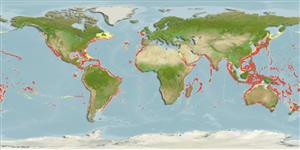Common names from other countries
Environment: milieu / climate zone / depth range / distribution range
Ecologie
Pelagisch; diepteverspreiding 100 - 850 m (Ref. 97142). Temperate; 52°N - 43°S, 34°E - 7°W (Ref. 275)
Circumglobal in northern and southern warm temperate waters.
Length at first maturity / Size / Gewicht / Leeftijd
Maturity: Lm ? range ? - ? cm Max length : 21.0 cm ML mannelijk/geslacht niet bekend; (Ref. 97142); 24 cm ML (female)
This species is an important prey for commercial species of fishes (Ref. 97142). Off Hawaii, occurs between depths of 100 and 850 m; in daytime it concentrates at 500 to 700 m (range 355 to 850 m) and vertically migrates at night to depths of 100 to 500 m with 85% concentrated at 150 to 300 m. In the northwestern Pacific transitional warm core rings and cold water, this species is a non-migrant, remaining below 400 m. Analysis of stomach contents from sperm whales off Japan suggests that mature females occur in a dense aggregation adjacent to an isolated oceanic rise. This species is extremely important prey for sperm whales and other odontocete whales, including short-finned pilot whales and Hubb’s beaked whale. Other predators include blue sharks in the northwestern Pacific. It is reported from the stomachs of swordfish off the west coast of Baja California, Mexico. Analysis of the dimorphic eyes suggests that the large left eye points upward and the small right eye points ventrolaterally when the animal is in its normal oblique, arms downward, position. This enables the squid in its daytime depth of 500 to 700 m, to use its large eye to utilize the dim daylight from above, while the small right eye perceives bioluminescent light from the side and below (Ref. 97142).
Life cycle and mating behavior
Geslachtsrijpheid | Voortplanting | Kuitschieten | Eieren | Fecundity | Larven
Members of the class Cephalopoda are gonochoric. Male and female adults usually die shortly after spawning and brooding, respectively. Mating behavior: Males perform various displays to attract potential females for copulation. During copulation, male grasp the female and inserts the hectocotylus into the female's mantle cavity where fertilization usually occurs. Life cycle: Embryos hatch into planktonic stage and live for some time before they grow larger and take up a benthic existence as adults.
Roper, C.F.E., M.J. Sweeney and C.E. Nauen. 1984. (Ref. 275)
Status op de Rode Lijst van het IUCN (Ref. 130435)
Status bij CITES (Ref. 108899)
Not Evaluated
Not Evaluated
Gebruik door de mens
| FishSource |
Tools
Meer informatie
Leeftijd/Grootte
Groei
Lengte-gewicht parameters
Lengte-lengte parameters
Morfologie
Larven
Abundantie
Internet-bronnen
Estimates based on models
Preferred temperature
(Ref.
115969): 8.5 - 18.6, mean 12.3 (based on 786 cells).
Kwetsbaarheid
Low vulnerability (10 of 100).
